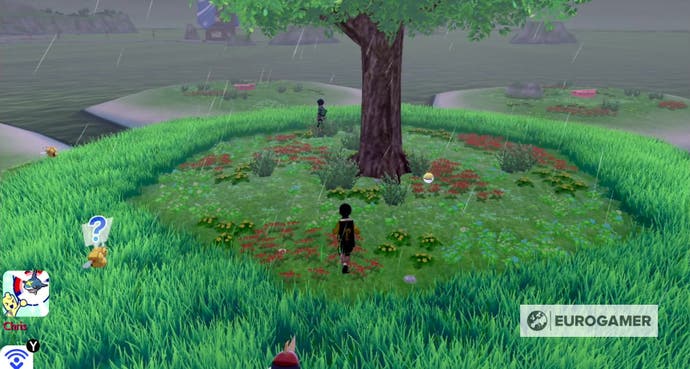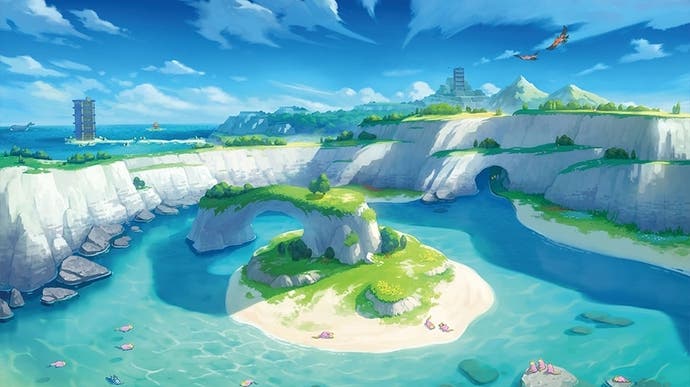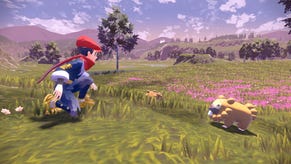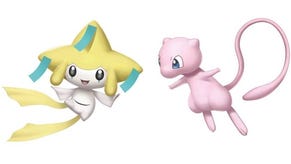Pok¨Śmon Sword and Shield: Isle of Armor review - baby steps towards an open world
Slowking but surely.
If you've finished it, you'll probably agree Pokémon Sword and Shield's postgame was a little under par. Aside from a brief, enjoyable, but nonsensical run-in with a phallically-quiffed Jedward, your options were mostly restricted to doodling about in the Wild Area or grinding it out indefinitely in the Battle Tower, earning items for competitive play online. It could be worse: the Wild Area is a break from the usual structure, at least, providing some lightly engaging raid events and - if you know where to look - a healthy and welcoming community of friendly raiders, hosts, and competitive sparring partners online.
The problem, though, remains that much of Pokémon's better communities and projects exist in spite of the game itself, as opposed to because of it. Max Raid battles are deeply, painfully repetitive, the few desirable Gigantamax Pokémon requiring an excruciating commitment to the grind without the help of semi-illicit raid groups online (again, you've got to know where to look). The Wild Area itself remains conceptually flat, despite the grassy bumps and mounds, with a total lack of mystery or intrigue compared to the postgame areas of previous generations, and there's little to no reason to visit or explore the rest of the game's Hollywood-western-town world. Puzzles and mystery seem gone with the wind.

Enter expansion one, The Isle of Armor. It's not the big solution to the main game's problems - it would be wrong to expect it to be - but if the Wild Area was the first baby step towards an open world, this is another in the right direction. There's a brief bit of cute story, a slightly more interesting topography to the environment (albeit still no puzzles, or anything close to it), and some useful, novel little systems to help with competitive play. That's about your lot, but even the refreshingly wide and open feel to the Isle of Man-inspired landscape provides a welcome break from the oddly oppressive vibe of the original Wild Area, contrarily surrounded by giant walls.
You'll arrive on the Isle of Armor to be greeted by a new, temporary rival, the snooty Klara or even more snooty Avery, in Sword and Shield's version respectively. Playing Sword, I can only speak for Klara, but there's a little more life to the animation with characters like her, it seems, as well as the Dojo chief Mustard and his partner Honey, who all carry more immediate magnetism and wit than just about any of the characters in the main games. After the curt introduction, there's some welcome freedom: you can head just about anywhere on the island, or go straight to the nearby Dojo to start a series of missions that make up the story segment of the DLC.

Predictably, the missions are very simple. Catch some runaway Slowpoke, pick some giant mushrooms, win a battle, beat five trainers in a tower, job done. If I'm being really harsh, they're like the simplest fetch quests of other open world games but without the gameplay along the way, your input effectively reduced to: go to the place you are repeatedly told about, physically shown, and pointed to on your map, maybe fight a battle, and come back.
What is interesting is the tweaks made for more competitively-inclined players. There are a good number of new moves to be learned by tutors, many of which, at least at first glance, seem like they'd have decent competitive uses. There's a person who'll wipe the EVs of a Pokémon for the cost of some minimal grinding which, to briefly explain for those uninitiated in this side of things, means it's easier to use Pokémon you've been casually using along the way for competitive purposes than before, where it would've often been faster to catch or breed a new one altogether. On that same note there's a new item-combining toy, the Cram-o-matic - that lets you turn three Silver Bottle Caps into a Gold one, allowing to engineer the stats of a given Pokémon up to competitive standard a fair bit faster (normally you'd need six Silver Caps to do the equivalent). There are also, of course, a good number of returning Pokémon to be found for the first time in this generation - including the rest of the Gen 1 and Gen 7 starters, with Gigantamax forms for the former by means of a special Max Soup - which expands the options of competitive players and just generally gives you more to get out there and catch, if you enjoy the collectathon.

Away from the hardcore side of things, Isle of Armor's experience is a breezy, easy-going one. There are new outfits and hairstyles - many of which are great, especially the Dojo one you get as part of the story, coming in a fetching yolk yellow - some typically cute character moments, like Mustard's tendency to move you out the way of the TV when he's kicking back some Pokémon Quest, and great touches to the wild Pokémon themselves. (Beware the hilariously terrifying Sharpedo when you head out to sea).
That, more or less, is that. There are more raid dens - many more - but no change to the agonising grind and poor UX of the raid experience, which remains too slow to enter, too hard to spot thanks to the game's shallow draw distance, too slow to get through, and simultaneously bland and frustrating to actually play (raid battles throw most of Pokémon's uniquely excellent battle mechanics out the window, making it an exercise in button-mashing a single move with your level 100 'mon of choice until it's done). There are effectively no trainers, barring the four single-Pokémon users you have to beat as part of the story to evolve Kubfu (which is an absolute treat of a new 'mon, in fairness to the little tyke), plus Mustard and your rival.
Those final two are frustrating also, because they might have been somewhat interesting to face - especially Mustard - had the base game not thrown experience candy and competitive training tools at you for months beforehand, leaving you completely overlevelled for the island (there's minimal level scaling, despite earlier suggestions from Nintendo spokespeople: it effectively works like the old Wild Area). There's also a smattering of other smaller distractions, from escaped Diglett acting as collectibles to a new restricted battle format that tasks you with fighting with and against just a single type of Pokémon. Rewards are fairly minimal - Alolan form Pokémon or new outfits, for the most part - but as diversions they're fun enough.
By Pokémon's standards, there are more quests and things to do here than we've had in some time, which brings me to the crux of the conversation, really. Are you here off the back of a major, rival RPG - on the Switch or off - or are you just after a bit more of the same, sunny comfort food? If it's the former, Pokémon's former muscle might be continuing to fade, perhaps quite drastically. If it's the latter, the Isle of Armor is an extra helping with a couple of cherries on top. Personally, I'm still a little hungry - and not just because everyone's named after food.










